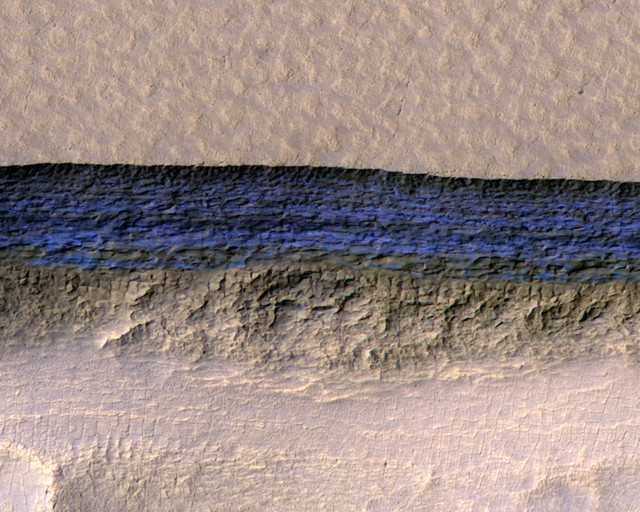
by Timothy Oleson Tuesday, March 20, 2018

A steep, ice-rich scarp (in blue) drops roughly 130 meters vertically in this color-enhanced image taken by the HiRISE camera aboard the Mars Reconnaissance Orbiter. Credit: NASA/JPL-Caltech/UA/USGS.
With two rovers patrolling the surface of Mars, six spacecraft orbiting above it, and scientists here on Earth studying the Red Planet from afar, new findings are announced often. Here are a few of the latest updates.
Roughly one third of Mars’ surface is underlain by shallow water ice deposits, although the thickness and vertical structure of these icy subsurface layers are not well known. In a new study in Science, imagery from the High Resolution Imaging Science Experiment (HiRISE) camera aboard the Mars Reconnaissance Orbiter has revealed high-resolution pictures of eight midlatitude sites where shallow, thick and layered ice deposits are exposed at the planet’s surface. The exposures — seven in the southern hemisphere and one in the northern hemisphere — all occur along steep, erosion-carved and poleward-facing scarps. “What we’ve seen here are cross sections through the ice that give us a three-dimensional view with more detail than ever before,” said lead author Colin Dundas of the U.S. Geological Survey’s Astrogeology Science Center in Flagstaff, Ariz., in a statement. The researchers determined that the ice deposits sit as little as 1 to 2 meters beneath the surface and may be more than 100 meters thick. They also identified distinct layers in each of the deposits — likely laid down originally as snow during times when Mars’ axis was heavily tilted toward the sun — suggesting that the ice has preserved a record of past climates. Given the shallowness and midlatitude locations of the deposits, the team noted that these sites could be possible destinations for future missions. “Astronauts could essentially just go there with a bucket and a shovel and get all the water they need,” said co-author Shane Byrne of the University of Arizona Lunar and Planetary Laboratory.
In a series of studies published in the Journal of Geophysical Research: Planets, researchers have detailed findings from the Curiosity rover’s visit to Bagnold Dunes — a large, active dune field on the northwestern flank of Mount Sharp — in late 2015 and early 2016, which offered the first on-the-ground observations of Martian dunes. In one study, Bethany Ehlmann of Caltech and colleagues reported that, compared to soils that Curiosity had previously studied, the Bagnold sands “are darker, less red, better sorted, have fewer silt-sized or smaller grains, and show no evidence for cohesion.” Blowing winds, which push the dunes laterally by up to 1 meter per year, are responsible for the enhanced sorting and shortage of fine grains, the team noted. Volcanic minerals like plagioclase, olivine and pyroxenes are prevalent in the sands, as at other locations on Mars, although the bulk soil composition at Bagnold is comparatively enriched in silicon, magnesium and nickel but depleted in water, sulfur and chlorine. In another study, Ryan Ewing of Texas A&M University and colleagues noted that wind-formed ripples and small-scale sand avalanches observed at Bagnold were similar to such features on Earth. The steepness that the Bagnold slopes achieve before sand falls downslope is also similar to terrestrial dunes, supporting the idea that “gravity plays little role in how steeply sand can pile up,” the researchers reported. However, Bagnold also hosts larger ripples, roughly a meter wide and up to 28 centimeters tall, that are not seen on Earth. These larger ripples are thought to form because of Mars’ low atmospheric density, and suggest that dunes preserved in the sedimentary records of Earth and Mars would look different from each other.
After previous discoveries of two types of aurorae on Mars’ night side, researchers now offer the first published report of so-called proton aurorae, which occur on the planet’s day side. (Proton aurorae on Mars were first announced in a presentation at the 2016 fall meeting of the American Geophysical Union.) These aurorae, which occur on Earth as well, happen when solar wind protons hit and excite atmospheric hydrogen atoms, which then give off visible and ultraviolet light. Birgit Ritter of the University of Liège in Belgium and colleagues searched data from the Spectroscopy for the Investigation of the Characteristics of the Atmosphere of Mars instrument aboard Mars Express. In Geophysical Research Letters, they reported “strong signatures” of six proton aurora events between 2004 and 2011. Each of these events, they noted, occurred as radiation arrived at Mars from either a coronal mass ejection or a co-rotating interaction region, which occurs when different streams of solar wind join together to create bursts of especially energetic radiation and intense magnetic fields.
© 2008-2021. All rights reserved. Any copying, redistribution or retransmission of any of the contents of this service without the expressed written permission of the American Geosciences Institute is expressly prohibited. Click here for all copyright requests.